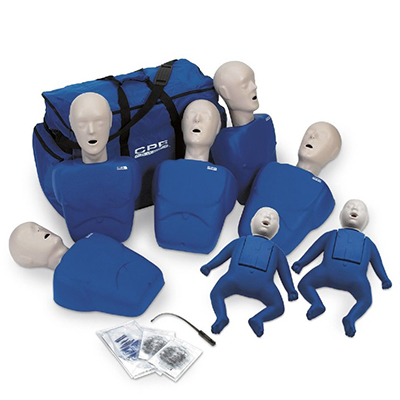A manikin is a human-shaped training device that provides simulation opportunities for students, first responders and emergency medical services (EMS) to practice cardiopulmonary resuscitation (CPR), airway management, or other life saving skill training. Individuals can practice medical and clinical scenarios in a safe, zero-stress environment without having to worry about dealing with a live victim.
Here, we’re going to talk about the importance of training manikins and the varied training scenarios that can be practiced with them. Keep reading to find out more!
History of Training Manikins
The first modern training manikin was first developed in the 1960s by Norwegian toy maker, Asmund Laerdal; American physician, James Elam; and Austrian-Czech physician, Peter Safar. The training manikin was called Resusci-Anne and it is still produced today by Laerdal Medical.
Manikin vs. Mannequin
Both manikin and mannequin derive from the Dutch word manneken, which means “little man.” The word once referred to small, articulated models used by artists, and the French spelling eventually began to describe a life-size doll used to display clothing and fashion. Manikin is the preferred spelling when referencing a patient simulator used for medical training, although the two spellings are commonly interchanged.
The Difference Between High-Fidelity and Low-Fidelity
Training manikins are available in different genders, as well as different ages and even skin tones. Adult manikins are used to practice adult CPR. Child manikins are used to practice pediatric CPR, and infant manikins are used to practice infant CPR. But all training manikins can be divided into two main types: high-fidelity and low-fidelity.
High- and low-fidelity indicate how realistic the manikin is. A high-fidelity manikin is equipped with the latest technology to provide the practitioner with feedback about their performance. Some high-fidelity manikins can even move, react, and display facial expressions. They are used for very specific training situations, such as practicing child delivery, severe injury, and other advanced life support (ALS) situations.
A low-fidelity manikin, on the other hand, will not have much (if any) technology on board to provide feedback to the user. They have simpler construction and are mainly used as CPR training manikins or for less complicated situations, like first aid, IV insertion training, or other basic life support (BLS) needs.
Proper Use of a CPR Training Manikin
Since CPR can cause injury to a person even when done correctly, training manikins are used to practice chest compressions and rescue breathing. These are typically performed as part of an instructional class.
Sometimes, a face shield or “pocket mask” will be required if everyone will be practicing on the same manikin while some classes issue a training manikin for each student. Other classes may give a mankin “face” to each student for the duration of class that can be attached to the training manikin when it’s time to practice.
Before each student uses the training manikin, a new lung bag is installed. The lung bag simulates the victim’s lungs and provides a realistic counterpart to human anatomy. Lung bags are equipped with a one-way valve so that air can be blown in, but escaping air can’t come back out and spread germs to other users. CPR training manikins can also be used to practice the use of an artificial manual breathing unit (AMBU), which is a manual device used to deliver positive pressure ventilation to a victim with either insufficient or ineffective breathing.
Advanced high-fidelity CPR training manikins will offer more feedback to the practitioner, such as CPR prompts to guide the student through the entire CPR process. These manikins could also be equipped with CPR rate monitors and ECG monitors to keep track of the students’ success.
Students should not eat or chew gum while participating in a CPR class as food particles could be blown into the lung bag. Students should also not wear lipstick while participating in a CPR class, as lipstick can stain the face of the training manikin.
Cleaning a Training Manikin
The risk of disease transmission from one person to another by a CPR training dummy is very low, but instructors should still take steps to ensure that students are protected.
The manikins’ faces should be wiped down regularly during class with a 70% isopropyl alcohol solution and then allowed a few minutes to dry.
After class has concluded, all training manikins should be disassembled and all lung bags discarded. Then wash all surfaces of the training manikin with warm, soapy water and a soft brush. After cleaning, disinfect all training dummies with a 70% isopropyl alcohol solution, or make your own cleaning solution by making a mixture of ¼ cup bleach per gallon of water. Wipe down all surfaces of the training manikins and allow all wiped surfaces to dry, then rinse with clean water and allow surfaces to dry again before storage or placement into a carry case or carry bag.
Other Medical Manikins
As we’ve discussed already, CPR training is only one of many functions that a training manikin can help with. There are manikins that can simulate almost any real-life medical scenario.
A training manikin does not necessarily have to include an entire body. Some manikins, for example, only consist of the head and upper torso. Manikins such as this are referred to as airway management trainers, and are used for the training of procedures like intubation. Other manikins are only a small section of the body, or a single limb. These are used to train for patient care procedures such as wound management and dressing, or taking blood pressure readings.
Another type of medical manikin is available to practice using an automated external defibrillator (AED), and is intended to be used in conjunction with an AED trainer to practice defibrillator use and pad placement.
Rescue Manikins
Besides medical training, manikins can also be employed to simulate rescue scenarios. For example, Rescue Randy from Simulaids is a training manikin used by fire departments and rescue teams to practice lifting and carrying unconscious victims to safety.
There are other styles of training manikins that are used for simulating water rescues. The manikin fills up with enough water so that it floats with just its head exposed to simulate someone treading water or wearing a life jacket. Practitioners can also add weight to the manikin to make it sink in order to practice extrication from underwater. Water rescue manikins also come in infant and child sizes.
Training is Essential
For first responders and others in the fields of medicine and emergency response, good practice can mean the difference between life and death. They need the best resources to practice with, because only perfect practice makes perfect. You can find all of the best training materials and tools in stock at Penn Care, your local stop for the best selection of medical supplies and equipment.



